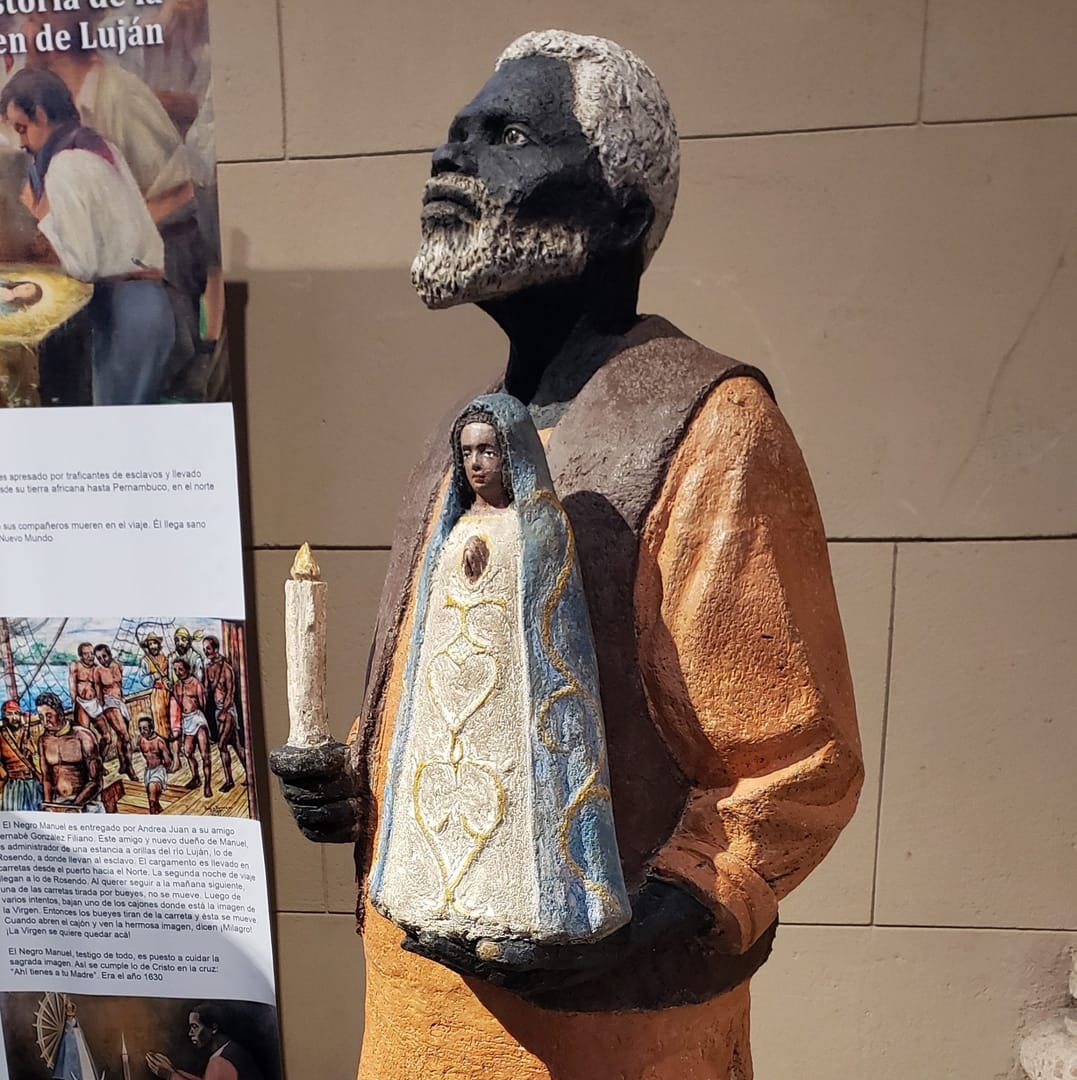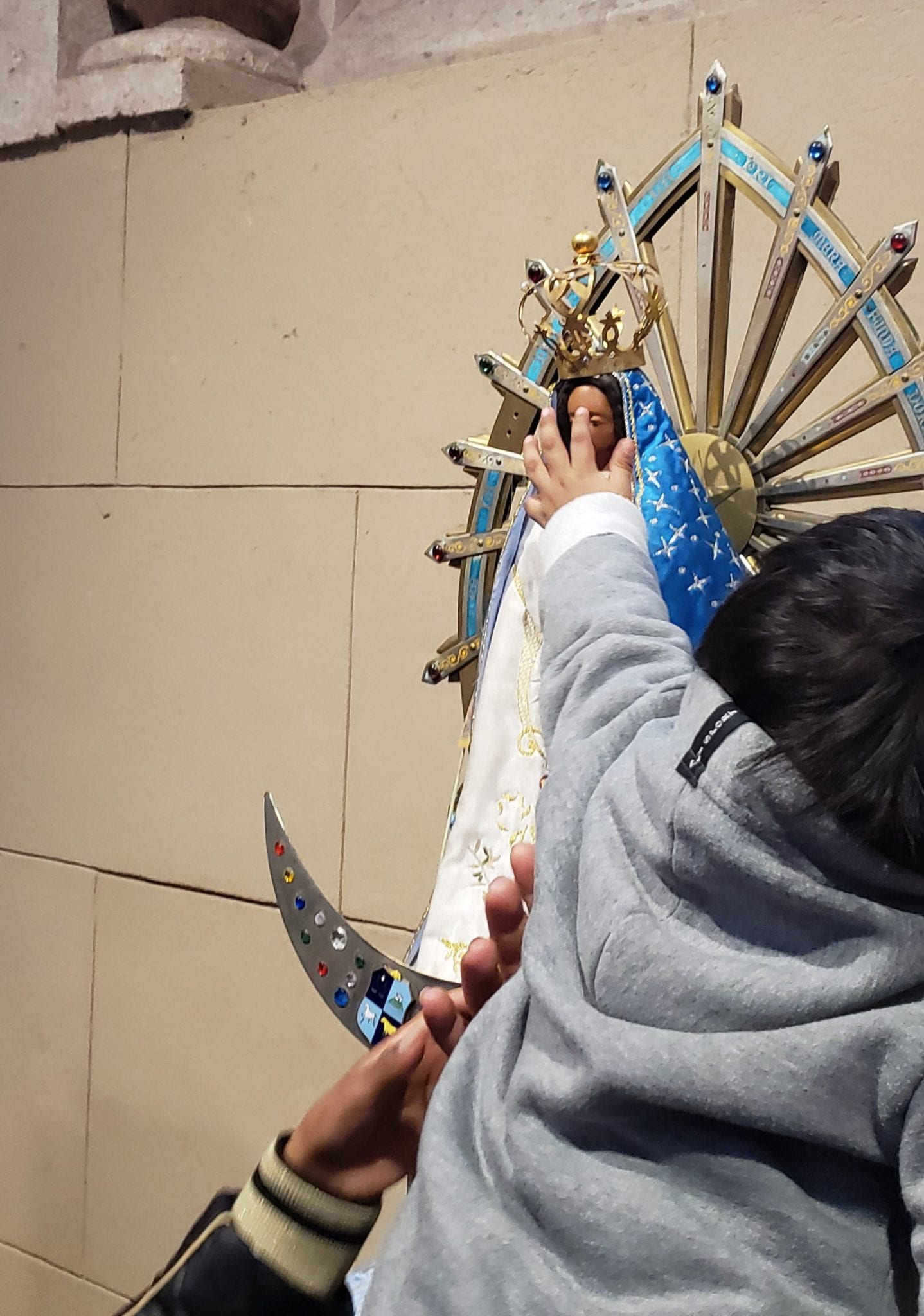LUJAN, Argentina – “I belong to Our Lady, and no one else.” These words were the defense posed by a black slave in Argentina when his owners tried to remove him from an image of the Virgin he’d protected during its transportation from Brazil to Argentina.
“El negro Manuel,” as he’s known in Pope Francis’s homeland, is currently in the process of being recognized as a saint by the Catholic Church.
His life story is at the Shrine of Our Lady of Lujan, next to a replica of the image he helped preserve which has been the official patroness of Argentina for over a century. The shrine is now visited by more than 5 million pilgrims each year.
Our Lady of Lujan is a 14-inch-tall terracotta image of Our Lady of the Immaculate Conception that has been venerated in Argentina since its arrival in 1630. According to tradition, the image “chose” to stay in Lujan, some 40 miles northwest of Buenos Aires. After three days of traveling in a caravan towards the northern region of Argentina, the two oxen pulling the statue’s cart stopped moving near the Lujan river.
After much coaxing, it became evident that the cart would only move if the image was left behind, and the Portuguese rancher who was transporting the statue agreed. Manuel had been “gifted” to a rancher in Lujan, who allowed the slave to dedicate his life to taking care of the image, which he did until he died, in 1686.
When those who “inherited” Manuel tried to take him away from his life-long task in 1674, the people of Lujan came together and bought his freedom. During the process, he would simply say “I belong to Our Lady, and no one else.”
As per his own words, “My owner, the Virgin,” had promised that he would die on a Friday and be in heaven by Saturday. He did, in fact, die on a Friday.
An image available online of a side table in Francis’s quarters in the Vatican shows a small image of Manuel next to that of Our Lady of Lujan and a crucifix made with wood from one of the shipwrecked migrants’ boats found on the coast of the island of Lampedusa in southern Italy.

The pope was personally informed of the beatification cause by those promoting it in 2016, and Francis reportedly told them the cause had his support.
When he was still the Archbishop of Buenos Aires, then-Cardinal Jorge Mario Bergoglio would go to Lujan often. Once a year, every October, he would welcome pilgrims walking from Buenos Aires to Lujan, hear confessions, celebrate Mass and even join them in their walk during the night.
He would often reference Manuel during his homilies. In 2003, for instance, he thanked the Virgin “for staying here in Lujan, to welcome us and to accompany us. And we also say thanks for the fact that Negro Manuel took care of her.”
The future pope explained the importance of the Lujan shrine in 2008, during the feast of St. Cajetan, venerated in Argentina as the patron saint of bread and work. Every October, thousands of young people leave from the Church of St. Cajetan to make a pilgrimage to Lujan, walking 38 miles.
God is the only one capable of “convoking to build a place for everyone. Here, in St. Cajetan it’s demonstrated, as it is in Lujan too … These are homes for everybody. A sacred place.”
“These are places for everyone,” he insisted, because these shrines are places built with faith, with a “pure vision, with no envy, a look of hope placed only in God.”
In these shrines, Bergoglio said, everyone is welcome, no one is excluded and there is no fighting. It’s a place built “by work filled with the love of all the workers – men and women – of our nation, those who wake up every day and go to work, those who don’t steal but work.”
A testament to this were the hundreds of thousands of members of the Bolivian community in Argentina, who celebrated their 63rd pilgrimage to the shrine to venerate Our Lady of Copacabana, patroness of Bolivia, on Sunday.
“The [Bolivian] pilgrimage began 63 years ago in an improvised, disorganized way,” Oscar Luciani, the mayor of Lujan told Crux.
Mayor since 2011, he took part in several of the Masses Bergoglio celebrated in Lujan, and Luciani said he’s convinced Francis will visit the shrine if he ever comes back to Argentina: “He loves this place because he’s very devoted to the Virgin.”
According to one of several priests who were hearing confessions on Sunday, that day’s celebration is always “interesting to experience,” as are all of the major pilgrimages to Lujan.
“You get to experience the faith of the people in ways you probably won’t during a regular Mass in a church in Buenos Aires,” he said. “This is not to say that one way is better than the other, but sometimes, seeing the person next to you ‘wear their faith on their sleeve’ can awaken something in you that was dormant.”
Three women who every week serve as volunteers directing the lines to the confessionals told Crux that any given Sunday, hundreds of people go to confession, and that it’s “rare” to find one of the four to six priests who are there almost permanently without a penitent at hand.

The youth pilgrimage every October
The first time a group of young people walked from St. Cajetan to Lujan was in October 25, 1975 – though they arrived the following day. Some 30,000 people had answered the invitation issued by Father Rafael Tello to ask the Virgin to protect Argentina.
Although October is a Marian month, the main reason for the timing- first Sunday of October- of the pilgrimage is that the weather was nicer in the South American spring.
In 1976, a Pentecost vigil gathered 2,000 young people, not a small number considering that two months earlier the army had staged a military coup and had taken control over the country.
That night, Tello said that the “Argentine Church will also have to be founded on the blood of martyrs. When one of those gathered here has to give their blood for Christ- and this will happen- know that it was because they had received the Holy Spirit.”
A seminarian who attended that vigil was killed a month later by the military, together with three priests and a second seminarian, in what’s known as the “Massacre at St. Patrick’s Church.”
Tello, who died in 2002, is considered one of the most prolific Argentine theologians, and together with Father Lucio Gera, he was the mind behind the “Theology of the People,” described as the Argentine response to Latin America’s Liberation Theology.
The priest realized that throughout the year, thousands walked to the shrine, disregarding the dangers this entailed; so he decided to organize one great pilgrimage.
The response he received from the hierarchy, though not of outright opposition, was tepid at best. The people, however, showed up in numbers that exceeded expectations.
Tello often had a complicated relationship with the hierarchy of the Church in Argentina.
In 2012, Bergoglio presented a book about the theologian in Argentina’s pontifical university, noting that he was there to present a work on the thought of a man who had been removed from the faculty.
“The hierarchy, that in his time thought it was convenient to remove him, is the one that today believes his thinking to be valid,” Bergoglio said. “Furthermore, it was the foundation of the evangelizing work in Argentina. I want to thank God for this.”
Tello’s evangelizing work was focused on fostering the faith among those who don’t attend Mass and instead express their faith in other ways, like 36-hour long pilgrimages or visiting St. Cajetan. To the latter, he would say to offer food, clothes and medicine instead of votive candles. To this day, trucks loaded with food, clothes, blankets and diapers are sent from the shrine to the slums that surround Buenos Aires. This request also laid the groundwork for many of the social ministries of the Catholic Church in Argentina.
Though it’s virtually impossible to determine how many people begin and end the October pilgrimage each year, estimates claim that close to a million people do at least several miles towards the shrine. According to the website of the pilgrimage, almost half of those who attend go alone, and 30 percent of the pilgrims are not part of a religious group, movement or ecclesial structure.
Father Carlos Galli, a theologian close to the pope, wrote in 2004 that if the “popular and solitary pilgrim seems to be self-summoned to Lujan or another sanctuary, he actually comes because he has been summoned by the loving attraction of God, Christ, the Holy Spirit, Mary or a saint, more than an organized pastoral action.”
Follow Inés San Martín on Twitter: @inesanma
________________________________________________
Crux is dedicated to smart, wired and independent reporting on the Vatican and worldwide Catholic Church. That kind of reporting doesn’t come cheap, and we need your support. You can help Crux by giving a small amount monthly, or with a onetime gift. Please remember, Crux is a for-profit organization, so contributions are not tax-deductible.


















